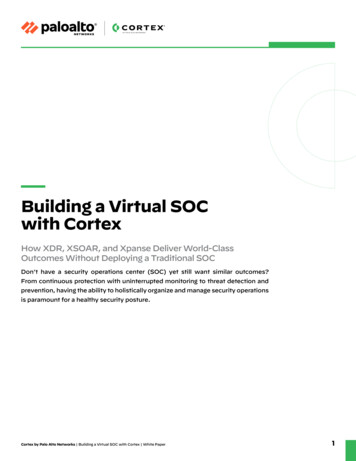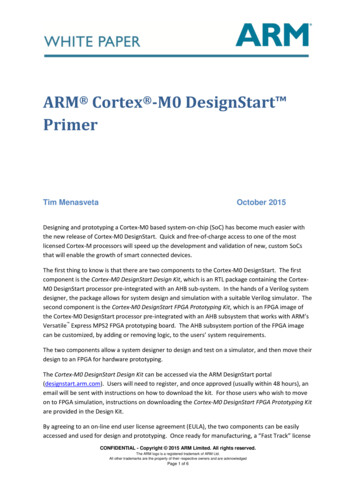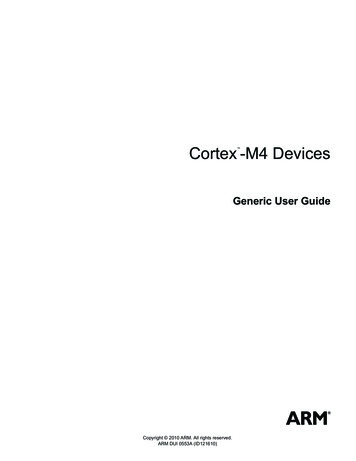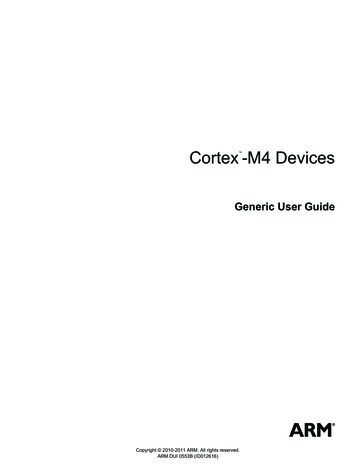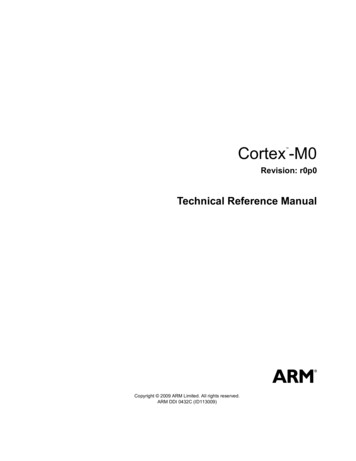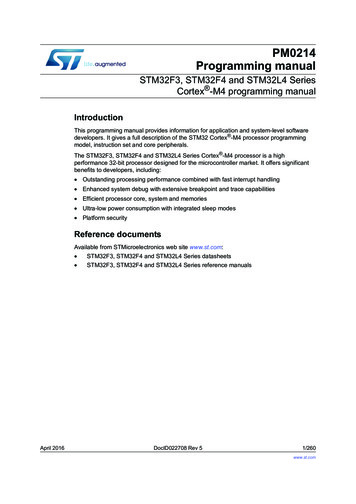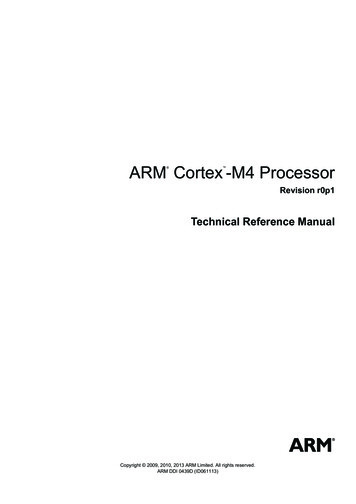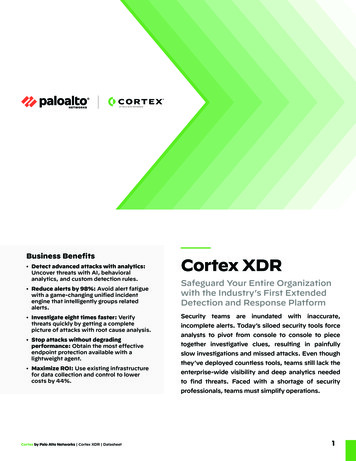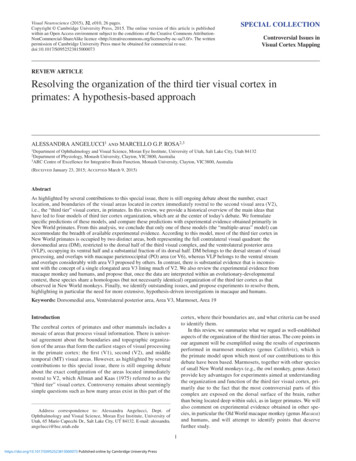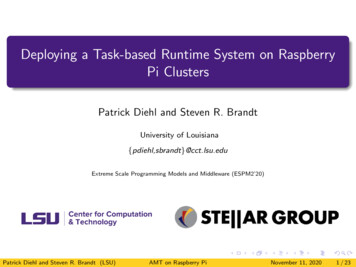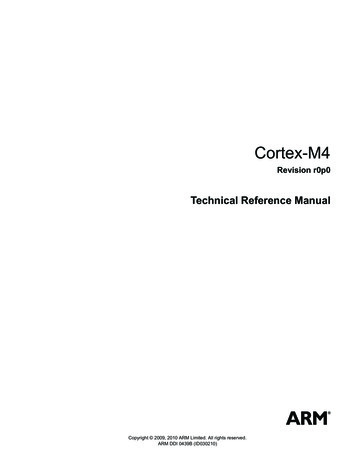
Transcription
Cortex-M4Revision r0p0Technical Reference ManualCopyright 2009, 2010 ARM Limited. All rights reserved.ARM DDI 0439B (ID030210)
Cortex-M4Technical Reference ManualCopyright 2009, 2010 ARM Limited. All rights reserved.Release InformationThe following changes have been made to this book.Change HistoryDateIssueConfidentialityChange22 December 2009ANon-Confidential, Restricted AccessFirst release for r0p002 March 2010BNon-ConfidentialSecond release for r0p0Proprietary NoticeWords and logos marked with or are registered trademarks or trademarks of ARM Limited in the EU and othercountries, except as otherwise stated in this proprietary notice. Other brands and names mentioned herein may be thetrademarks of their respective owners.Neither the whole nor any part of the information contained in, or the product described in, this document may beadapted or reproduced in any material form except with the prior written permission of the copyright holder.The product described in this document is subject to continuous developments and improvements. All particulars of theproduct and its use contained in this document are given by ARM Limited in good faith. However, all warranties impliedor expressed, including but not limited to implied warranties of merchantability, or fitness for purpose, are excluded.This document is intended only to assist the reader in the use of the product. ARM Limited shall not be liable for anyloss or damage arising from the use of any information in this document, or any error or omission in such information,or any incorrect use of the product.Where the term ARM is used it means “ARM or any of its subsidiaries as appropriate”.Some material in this document is based on IEEE 754-2008 IEEE Standard for Binary Floating-Point Arithmetic. TheIEEE disclaims any responsibility or liability resulting from the placement and use in the described manner.Confidentiality StatusThis document is Non-Confidential. The right to use, copy and disclose this document may be subject to licenserestrictions in accordance with the terms of the agreement entered into by ARM and the party that ARM delivered thisdocument to.Unrestricted Access is an ARM internal classification.Product StatusThe information in this document is Final (information on a developed product).Web Addresshttp://www.arm.comARM DDI 0439BID030210Copyright 2009, 2010 ARM Limited. All rights reserved.Non-Confidential, Unrestricted Accessii
ContentsCortex-M4 Technical Reference ManualPrefaceAbout this book . ixFeedback . xiChapter 1Introduction1.11.21.31.41.5Chapter 2About the programmers model . 3-2Modes of operation and execution . 3-3Instruction set summary . 3-4System address map . 3-14Write buffer . 3-17Exclusive monitor . 3-18Bit-banding . 3-19Processor core register summary . 3-21Exceptions . 3-23System Control4.1ARM DDI 0439BID030210About the functions . 2-2Interfaces . 2-5Programmers Model3.13.23.33.43.53.63.73.83.9Chapter 41-21-31-41-51-6Functional Description2.12.2Chapter 3About the processor .Features .Interfaces .Configurable options .Product documentation .About system control . 4-2Copyright 2009, 2010 ARM Limited. All rights reserved.Non-Confidential, Unrestricted Accessiii
Contents4.24.3Chapter 5Register summary . 4-3Register descriptions . 4-5Memory Protection Unit5.15.25.3Chapter 6About the MPU . 5-2MPU functional description . 5-3MPU programmers model . 5-4Nested Vectored Interrupt Controller6.16.26.3Chapter 7About the NVIC . 6-2NVIC functional description . 6-3NVIC programmers model . 6-4Floating Point Unit7.17.27.3Chapter 8Debug8.18.28.3Chapter 9About the ITM . 10-2ITM functional description . 10-3ITM programmers model . 10-4Trace Port Interface Unit11.111.211.3Appendix AAbout the DWT . 9-2DWT functional description . 9-3DWT Programmers Model . 9-4Instrumentation Trace Macrocell Unit10.110.210.3Chapter 11About debug . 8-2About the AHB-AP . 8-6About the Flash Patch and Breakpoint Unit (FPB) . 8-9Data Watchpoint and Trace Unit9.19.29.3Chapter 10About the FPU . 7-2FPU Functional Description . 7-3FPU Programmers Model . 7-9About the Cortex-M4 TPIU . 11-2TPIU functional description . 11-3TPIU programmers model . 11-5RevisionsGlossaryARM DDI 0439BID030210Copyright 2009, 2010 ARM Limited. All rights reserved.Non-Confidential, Unrestricted Accessiv
List of TablesCortex-M4 Technical Reference ManualTable 3-1Table 3-2Table 3-3Table 4-1Table 4-2Table 4-3Table 4-4Table 5-1Table 6-1Table 6-2Table 7-1Table 7-2Table 7-3Table 7-4Table 8-1Table 8-2Table 8-3Table 8-4Table 8-5Table 8-6Table 8-7Table 9-1Table 10-1Table 10-2Table 11-1Table 11-2Table 11-3Table 11-4Table 11-5ARM DDI 0439BID030210Change History . iiCortex-M4 instruction set summary . 3-4Cortex-M4 DSP instruction set summary . 3-8Memory regions . 3-14System control registers . 4-3ACTLR bit assignments . 4-5CPUID bit assignments . 4-6AFSR bit assignments . 4-7MPU registers . 5-4NVIC registers . 6-4ICTR bit assignments . 6-5FPU instruction set . 7-4Default NaN values . 7-6QNaN and SNaN handling . 7-7Cortex-M4F Floating Point system registers . 7-9Cortex-M4 ROM table identification values . 8-3Cortex-M4 ROM table components . 8-3SCS identification values . 8-4Debug registers . 8-5AHB-AP register summary . 8-6CSW bit assignments . 8-7FPB register summary . 8-10DWT register summary . 9-4ITM register summary . 10-4ITM TPR bit assignments . 10-5TPIU registers . 11-5TPIU ACPR bit assignments . 11-6TPIU FFSR bit assignments . 11-7TPIU FFCR bit assignments . 11-7TRIGGER bit assignments . 11-8Copyright 2009, 2010 ARM Limited. All rights reserved.Non-Confidential, Unrestricted Accessv
List of TablesTable 11-6Table 11-7Table 11-8Table 11-9Table 11-10Table 11-11Table A-1Table A-2ARM DDI 0439BID030210Integration ETM Data bit assignments . 11-9ITATBCTR2 bit assignments . 11-10Integration ITM Data bit assignments . 11-10ITATBCTR0 bit assignments . 11-11TPIU ITCTRL bit assignments . 11-12TPIU DEVID bit assignments . 11-12Issue A . A-1Differences between issue A and issue BC . A-1Copyright 2009, 2010 ARM Limited. All rights reserved.Non-Confidential, Unrestricted Accessvi
List of FiguresCortex-M4 Technical Reference ManualFigure 2-1Figure 3-1Figure 3-2Figure 3-3Figure 4-1Figure 4-2Figure 4-3Figure 6-1Figure 7-1Figure 8-1Figure 8-2Figure 10-1Figure 11-1Figure 11-2Figure 11-3Figure 11-4Figure 11-5Figure 11-6Figure 11-7Figure 11-8Figure 11-9Figure 11-10Figure 11-11ARM DDI 0439BID030210Cortex-M4 block diagram . 2-2System address map . 3-14Bit-band mapping . 3-20Processor register set . 3-21ACTLR bit assignments . 4-5CPUID bit assignments . 4-6AFSR bit assignments . 4-6ICTR bit assignments . 6-4FPU register bank . 7-3CoreSight discovery . 8-2CSW bit assignments . 8-7ITM TPR bit assignments . 10-5TPIU block diagram . 11-3TPIU ACPR bit assignments . 11-6TPIU FFSR bit assignments . 11-6TPIU FFCR bit assignments . 11-7TRIGGER bit assignments . 11-8Integration ETM Data bit assignments . 11-9ITATBCTR2 bit assignments . 11-9Integration ITM Data bit assignments . 11-10ITATBCTR0 bit assignments . 11-11TPIU ITCTRL bit assignments . 11-11TPIU DEVID bit assignments . 11-12Copyright 2009, 2010 ARM Limited. All rights reserved.Non-Confidential, Unrestricted Accessvii
PrefaceThis preface introduces the Cortex-M4 Technical Reference Manual (TRM). It contains thefollowing sections: About this book on page ix Feedback on page xi.ARM DDI 0439BID030210Copyright 2009, 2010 ARM Limited. All rights reserved.Non-Confidential, Unrestricted Accessviii
PrefaceAbout this bookThis book is for the Cortex-M4 processor.Product revision statusThe rnpn identifier indicates the revision status of the product described in this manual, where:rnIdentifies the major revision of the product.pnIdentifies the minor revision or modification status of the product.Intended audienceThis manual is written to help system designers, system integrators, verification engineers, andsoftware programmers who are implementing a System-on-Chip (SoC) device based on theCortex-M4 processor.Using this bookThis book is organized into the following chapters:Chapter 1 IntroductionRead this for a description of the components of the processor, and of the productdocumentation.Chapter 2 Functional DescriptionRead this for a description of the functionality of the processor.Chapter 3 Programmers ModelRead this for a description of the processor register set, modes of operation, andother information for programming the processor.Chapter 4 System ControlRead this for a description of the registers and programmers model for systemcontrol.Chapter 5 Memory Protection UnitRead this for a description of the Memory Protection Unit (MPU).Chapter 6 Nested Vectored Interrupt ControllerRead this for a description of the interrupt processing and control.Chapter 7 Floating Point UnitRead this for a description of the Floating Point Unit (FPU)Chapter 8 DebugRead this for information about debugging and testing the processor core.Chapter 9 Data Watchpoint and Trace UnitRead this for a description of the Data Watchpoint and Trace (DWT) unit.Chapter 10 Instrumentation Trace Macrocell UnitRead this for a description of the Instrumentation Trace Macrocell (ITM) unit.Chapter 11 Trace Port Interface UnitRead this for a description of the Trace Port Interface Unit (TPIU).ARM DDI 0439BID030210Copyright 2009, 2010 ARM Limited. All rights reserved.Non-Confidential, Unrestricted Accessix
PrefaceGlossaryRead this for definitions of terms used in this book.ConventionsConventions that this book can use are described in: TypographicalTypographicalThe typographical conventions are:italicHighlights important notes, introduces special terminology, denotesinternal cross-references, and citations.boldHighlights interface elements, such as menu names. Denotes signalnames. Also used for terms in descriptive lists, where appropriate.monospaceDenotes text that you can enter at the keyboard, such as commands, fileand program names, and source code.monospaceDenotes a permitted abbreviation for a command or option. You can enterthe underlined text instead of the full command or option name.monospace italicDenotes arguments to monospace text where the argument is to bereplaced by a specific value.monospaceDenotes language keywords when used outside example code. and Enclose replaceable terms for assembler syntax where they appear in codeor code fragments. For example:ADD Rd, Rn, op2 Additional readingThis section lists publications by ARM and by third parties.See Infocenter, http://infocenter.arm.com, for access to ARM documentation.ARM publicationsThis book contains information that is specific to this product. See the following documents forother relevant information: ARMv7-M Architecture Reference Manual (ARM DDI 0403) ARM Cortex-M4 Integration and Implementation Manual (ARM DII 0239) ARM ETM-M4 Technical Reference Manual (ARM DDI 0440) ARM AMBA 3 AHB-Lite Protocol (v1.0) (ARM IHI 0033) ARM AMBA 3 APB Protocol Specification (ARM IHI 0024) ARM CoreSight Components Technical Reference Manual (ARM DDI 0314) ARM Debug Interface v5 Architecture Specification (ARM IHI 0031) ARM Embedded Trace Macrocell Architecture Specification (ARM IHI 0014).Other publicationsThis section lists relevant documents published by third parties: IEEE Standard Test Access Port and Boundary-Scan Architecture 1149.1-2001 (JTAG) IEEE Standard IEEE Standard for Binary Floating-Point Arithmetic 754-2008.ARM DDI 0439BID030210Copyright 2009, 2010 ARM Limited. All rights reserved.Non-Confidential, Unrestricted Accessx
PrefaceFeedbackARM welcomes feedback on this product and its documentation.Feedback on this productIf you have any comments or suggestions about this product, contact your supplier and give: The product name. The product revision or version. An explanation with as much information as you can provide. Include symptoms anddiagnostic procedures if appropriate.Feedback on this manualIf you have comments on content then send e-mail to errata@arm.com. Give: the title the number, ARM DDI 0439 the page number(s) to which your comments refer a concise explanation of your comments.ARM also welcomes general suggestions for additions and improvements.ARM DDI 0439BID030210Copyright 2009, 2010 ARM Limited. All rights reserved.Non-Confidential, Unrestricted Accessxi
Chapter 1IntroductionThis chapter introduces the processor and instruction set. It contains the following sections: About the processor on page 1-2 Features on page 1-3 Interfaces on page 1-4 Configurable options on page 1-5 Product documentation on page 1-6ARM DDI 0439BID030210Copyright 2009, 2010 ARM Limited. All rights reserved.Non-Confidential, Unrestricted Access1-1
Introduction1.1About the processorThe Cortex-M4 processor is a low-power processor that features low gate count, low interruptlatency, and low-cost debug. The Cortex-M4F is a processor with the same capability as theCortex-M4 processor, and includes floating point arithmetic functionality (see Chapter 7Floating Point Unit). Both processors are intended for deeply embedded applications thatrequire fast interrupt response features.Throughout this document the name Cortex-M4 refers to both Cortex-M4 and Cortex-M4Fprocessors unless otherwise indicated.ARM DDI 0439BID030210Copyright 2009, 2010 ARM Limited. All rights reserved.Non-Confidential, Unrestricted Access1-2
Introduction1.2FeaturesThe Cortex-M4 processor incorporates:ARM DDI 0439BID030210 A processor core A Nested Vectored Interrupt Controller (NVIC) closely integrated with the processor coreto achieve low latency interrupt processing Multiple high-performance bus interfaces A low-cost debug solution with the optional ability to:— implement breakpoints and code patches— implement watchpoints, tracing, and system profiling— support printf style debugging.— bridge to a Trace Port Analyzer (TPA) An optional Memory Protection Unit (MPU). A Floating Point Unit (FPU) unit, in the Cortex-M4F processor.Copyright 2009, 2010 ARM Limited. All rights reserved.Non-Confidential, Unrestricted Access1-3
Introduction1.3InterfacesThe processor has the following external interfaces: multiple memory and device bus interfaces ETM interface trace port interface debug port interface.ARM DDI 0439BID030210Copyright 2009, 2010 ARM Limited. All rights reserved.Non-Confidential, Unrestricted Access1-4
Introduction1.4Configurable optionsYou can configure your Cortex-M4 implementation to include the following optionalcomponents: MPU. See Chapter 5 Memory Protection Unit. FPB. See Chapter 8 Debug. DWT. See Chapter 9 Data Watchpoint and Trace Unit. ITM. See Chapter 10 Instrumentation Trace Macrocell Unit. ETM. See the ETM-M4 Technical Reference Manual. AHB-AP. See Chapter 8 Debug. HTM interface. See AHB Trace Macrocell interface on page 2-6. TPIU. See Chapter 11 Trace Port Interface Unit. WIC. See Low power modes on page 6-3. Debug Port. See Debug port AHB-AP interface on page 2-6 FPU. See Chapter 7 Floating Point Unit. Bit-banding, see Bit-banding on page 3-19NoteYou can only configure trace functionality in the following combinations: no trace functionality ITM and DWT ITM, DWT, and ETM ITM, DWT, ETM, and HTM.You can configure the features provided in the DWT independently.ARM DDI 0439BID030210Copyright 2009, 2010 ARM Limited. All rights reserved.Non-Confidential, Unrestricted Access1-5
Introduction1.5Product documentationThis section describes the processor books, how they relate to the design flow, and the relevantarchitectural standards and protocols.See Additional reading on page x for more information about the books described in thissection.1.5.1DocumentationThe Cortex-M4 documentation is as follows:Technical Reference ManualThe Technical Reference Manual (TRM) describes the functionality and theeffects of functional options on the behavior of the Cortex-M4 processor. It isrequired at all stages of the design flow. Some behavior described in the TRMmight not be relevant because of the way that the Cortex-M4 processor isimplemented and integrated. If you are programming the Cortex-M4 processorthen contact: the implementor to determine:—the build configuration of the implementation—what integration, if any, was performed before implementing theprocessorthe integrator to determine the pin configuration of the SoC that you areusing.Integration and Implementation ManualThe Integration and Implementation Manual (IIM) describes: The available build configuration options and related issues in selectingthem. How to configure the Register Transfer Level (RTL) with the buildconfiguration options How to integrate the processor into a SoC. This includes a description ofthe integration kit and describes the pins that the integrator must tie off toconfigure the macrocell for the required integration. How to implement the processor into your design. This includesfloorplanning guidelines, Design for Test (DFT) information, and how toperform netlist dynamic verification on the processor. The processes to sign off the integration and implementation of the design.The ARM product deliverables include reference scripts and information aboutusing them to implement your design.Reference methodology documentation from your EDA tools vendorcomplements the IIM.The IIM is a confidential book that is only available to licensees.ETM-M4 Technical Reference ManualThe ETM-M4 Technical Reference Manual (TRM) describes the functionalityand behavior of the Cortex-M4 Embedded Trace Macrocell. It is required at allstages of the design flow. Typically the ETM-M4 is integrated with theCortex-M4 processor prior to implementation as a single macrocell.ARM DDI 0439BID030210Copyright 2009, 2010 ARM Limited. All rights reserved.Non-Confidential, Unrestricted Access1-6
IntroductionCortex-M4 User Guide Reference MaterialThis document provides reference material that ARM partners can configure andinclude in a User Guide for an ARM Cortex-M4 processor. Typically: each chapter in this reference material might correspond to a section in theUser Guide each top-level section in this reference material might correspond to achapter in the User Guide.However, you can organize this material in any way, subject to the conditions ofthe licence agreement under which ARM supplied the material.1.5.2Design FlowThe processor is delivered as synthesizable RTL. Before it can be used in a product, it must gothrough the following process:ImplementationThe implementor configures and synthesizes the RTL to produce a hardmacrocell. This might include integrating RAMs into the design.Integration The integrator connects the implemented design into a SoC. This includesconnecting it to a memory system and peripherals.ProgrammingThe system programmer develops the software required to configure andinitialize the processor, and tests the required application software.Each stage in the process can be performed by a different party. Implementation and integrationchoices affect the behavior and features of the processor.For MCUs, often a single design team integrates the processor before synthesizing the completedesign. Alternatively, the team can synthesise the processor on its own or partially integrated,to produce a macrocell that is then integrated, possibly by a separate team.The operation of the final device depends on:Build configurationThe implementor chooses the options that affect how the RTL source files arepre-processed. These options usually include or exclude logic that affects one ormore of the area, maximum frequency, and features of the resulting macrocell.Configuration inputsThe integrator configures some features of the processor by
This book is for the Cortex-M4 processor. Product revision status The r n p n identifier indicates the revisi on status of the product described in this manual, where:
